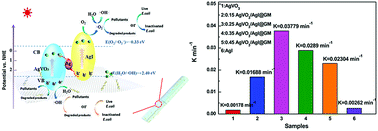An in situ ion exchange grown visible-light-driven Z-scheme AgVO3/AgI graphene microtube for enhanced photocatalytic performance†
Abstract
Both the visible light excitation and effective recycling play very important roles in the photocatalysis field. In this study, a novel visible-light-driven Z-scheme AgVO3/AgI graphene microtube (AgVO3/AgI@GM) was fabricated via in situ ion exchange and hydrothermal methods. A series of characterization tests were performed and the results demonstrated that the AgVO3/AgI@GM synergistically integrated the structural and functional virtues of AgVO3 and AgI onto the macroscopic hollow graphene microtube with good conductivity. In this composite, AgVO3 nanowires were uniformly dispersed on the surface of graphene microtubules due to the chelation of chitosan and acted as an Ag source to generate AgI on the surface by an ion-exchange effect, which prevents AgVO3 and AgI agglomeration/shedding in photocatalytic applications and helps improve the photocatalytic performance and cyclic stability. The hollow graphene microtube is beneficial for improving the mass-transport efficiency in photocatalytic processes and its macrostructure is conducive to recycling. Profiting from its unique function and structure, AgVO3/AgI@GM displayed excellent photodegradation performance for methyl orange (93% removal rate in 60 min) and a disinfection capacity for Escherichia coli (100% antibacterial efficiency in 45 min), and could retain its outstanding photocatalytic activity after five cycles.



 Please wait while we load your content...
Please wait while we load your content...